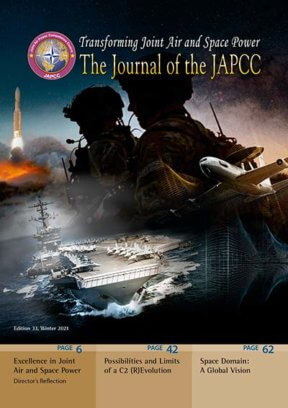Editorial
It is a great honour to introduce myself as the new editor of the Journal of the JAPCC, and as the newly appointed Assistant Director of the JAPCC. The role of editor is a significant responsibility and I am excited about the future of the journal and committed to helping continue the impressive trajectory it has established over the past 16 years.
A special thanks to our contributing authors starting with our Director, General Harrigian, for what will be his final piece as JAPCC Director. General Harrigian highlights the actions and adaptations undertaken in the Air and Space domains to maintain a competitive edge in the face of the rapidly advancing threats and technology. Continuing under the heading, ‘Leadership Perspective’, Lieutenant General Luyt, outlines the RNLAF’s ongoing process to become a 5th Generation Air Force and emphasizes the crucial role played by the dedicated innovative and transformative units.
The ‘Transformation & Capabilities’ section unfolds with the article ‘25 Years of Integrated Air and Missile Defence Training’ describing the evolution of the JPOW exercise series experimenting and incorporating more and more assets and players along with transitioning from TMD to IAMD. ‘Beyond SEAD’ brings into focus the encompassing JADO concept and how the employment of joint capabilities, in a layered approach, can be useful in unlocking the A2/AD problem. ‘Air-Land Integration – Bridging the Gaps in Joint with Force Education and Training’ builds on a previous article published in edition 30 and brings to surface the need for properly trained personnel to achieve effective joint ALI and interoperability. The following article, ‘Defending Space in and through Cyberspace’ emphasizes the importance of effectively addressing all cyber concerns and challenges for the protection of space assets. The ‘Possibilities and Limits of a C2 (R)Evolution’ article explains how new technological achievements should drive the need for new C2 constructs and exemplifies with instances from the SBAMD realm. Moving further, the ‘Responsive Space for NATO Operations – Part 3’ article is the concluding piece of the series published in editions 31 and 32. ‘Potential Game Changer for Close Air Support’ then explores how an enhanced UAS role in contested environments can deliver timely and responsive CAS for operations.
Advancing to the ‘Viewpoints’ section, the article ‘Space Domain: A Global Vision’ brings forward the need to increase resiliency and survivability of our space assets. ‘Meeting the Needs of Future Warfare’ addresses JAPCC’s support to the NATO training and exercise endeavour. Concluding this section, the article ‘To Be or Not to Be Classified’ advocates for a releasable to the public version of the Space Policy. Finally, under the ‘Out of the Box’ section, ‘The TLP and the Pace of Change’ article deals with the organization’s most current challenges.
Thank you for taking the time to read this edition of our Journal. We hope you will find it informative and stimulating and we greatly appreciate any feedback, thoughts, or ideas you may wish to share. I encourage you to reach out to us via our website at www.japcc.org, like us on LinkedIn or Twitter, or send us an email to .
Paul Herber
Air Commodore, NE AF
Assistant Director, JAPCC








